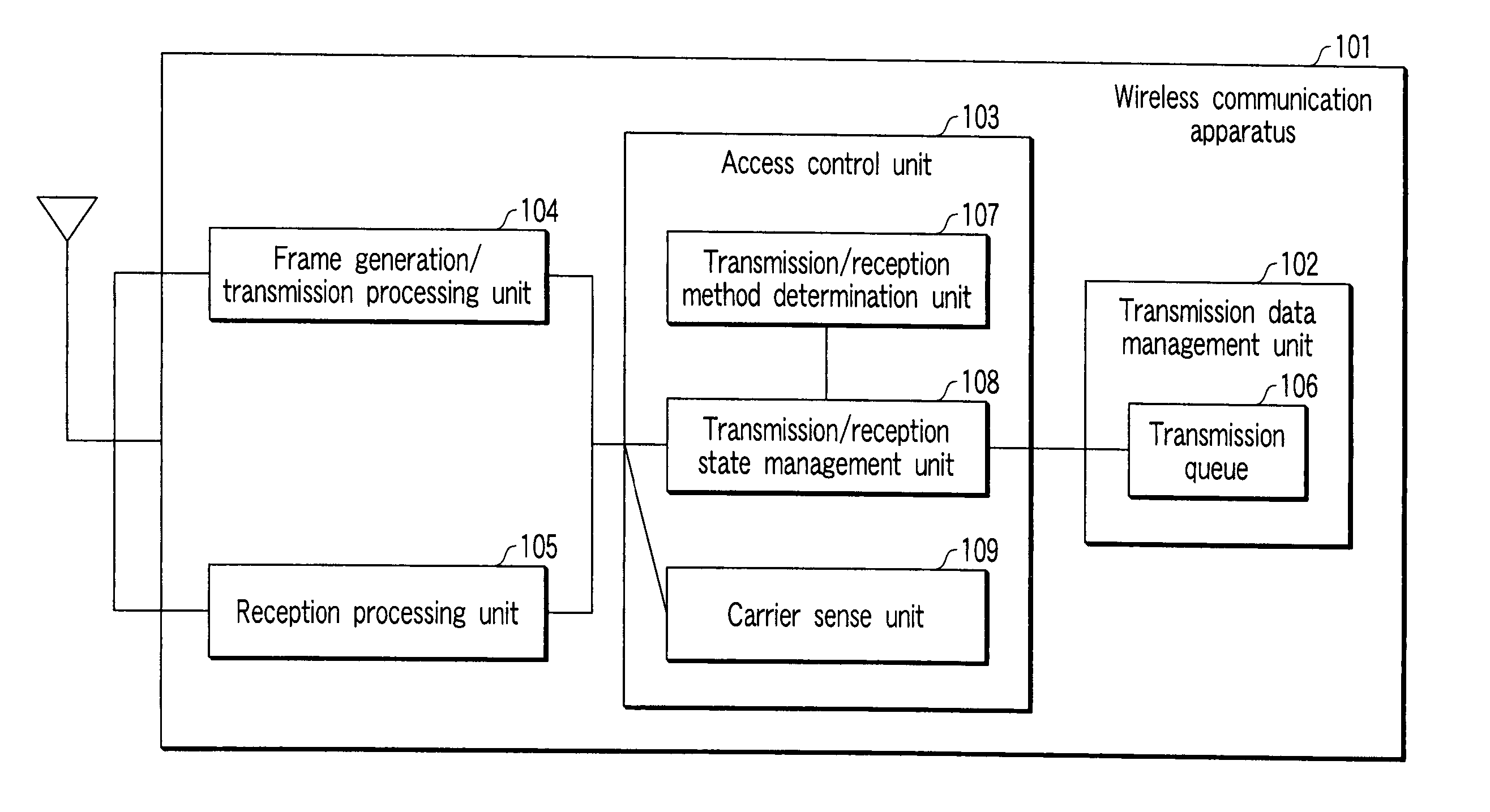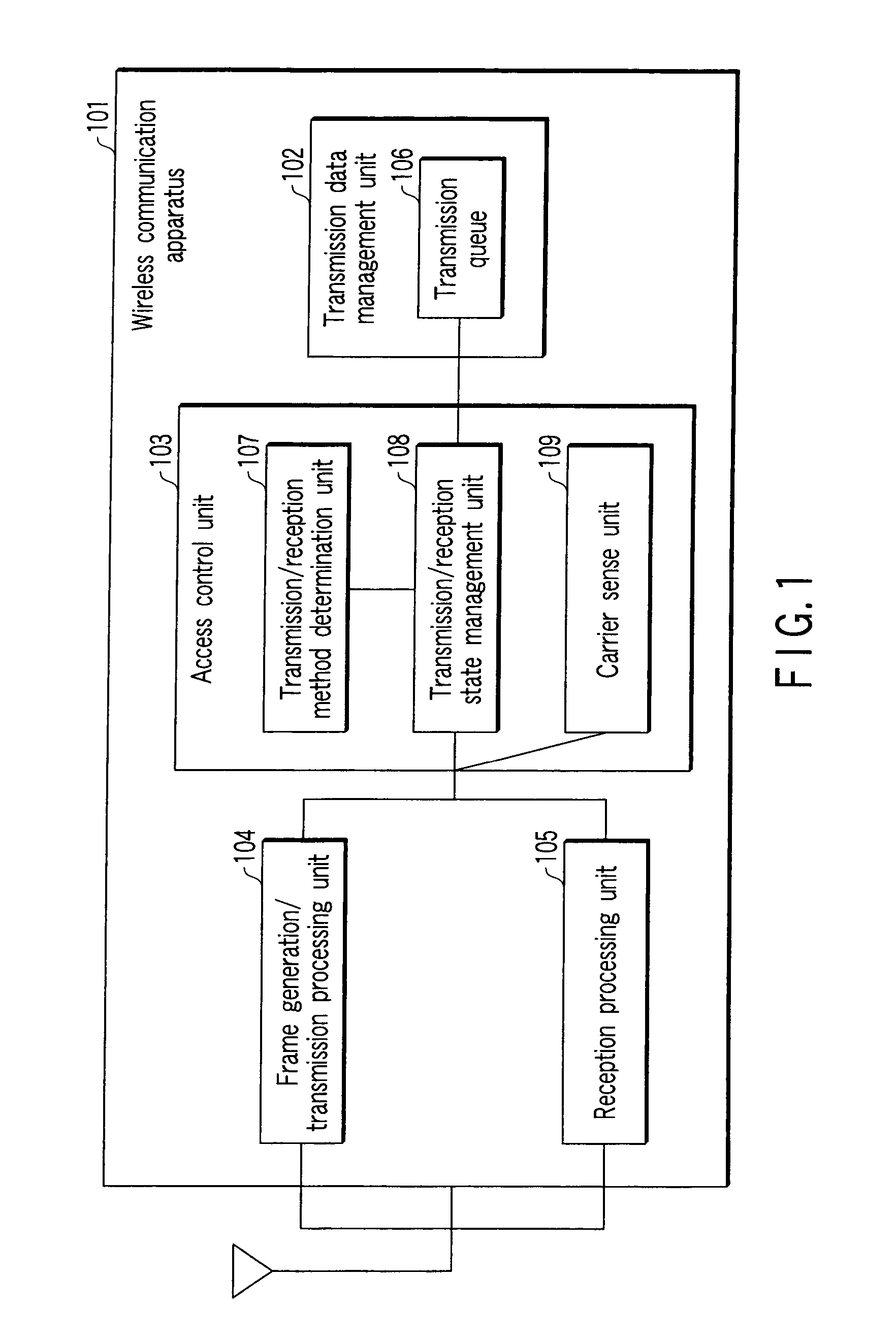Wireless communication apparatus and method
a communication apparatus and wireless technology, applied in the field of wireless communication apparatus and methods, can solve the problems of great reduction in throughput, and achieve the effects of reducing the success probability of blockack frame and blockackrequest frame, excessive deterioration in communication efficiency, and reducing throughpu
- Summary
- Abstract
- Description
- Claims
- Application Information
AI Technical Summary
Benefits of technology
Problems solved by technology
Method used
Image
Examples
first embodiment
[0043]FIG. 1 is a block diagram associated with an example of a wireless communication apparatus 101 which supports the contents proposed in IEEE 802.11n wireless LAN communication specifications. That is, the following description will be made on the assumption that a high transmission rate in the Multiple Input, Multiple Output (MIMO) scheme proposed in IEEE 802.11n and the transmission scheme in which the frequency band is extended from the 20 MHz band to the 40 MHz band are supported.
[0044] Assume that the contents proposed in IEEE 802.11n described below include all the IEEE 802.11 standard specifications, IEEE 802.11a / b / g / e, and the like (including those regarded as amendments, recommended practices, and the like).
[0045] It is needless to say that IEEE 802.11n is an example, and the present invention can be applied to wireless communication schemes, in general.
[0046] The wireless communication apparatus 101 comprises a transmission data management unit 102, access control u...
first modification
of First Embodiment
[0136] In the first embodiment, the terminal A 201 writes the TXOP allocation time in a QoS Cf-Poll+Data frame. That is, the terminal A 201 notifies the terminal B 202 of the TXOP allocation time. The terminal B 202 transmits transmission data of an amount which does not exceed an amount corresponding to the allocated TXOP allocation time.
[0137] However, the terminal B 202 may be designed to transmit transmission data as much as it wants to transmit regardless of the TXOP allocation time.
[0138] In such a case, the terminal A 201 need not write the TXOP allocation time in a QoS Cf-Poll+Data frame. It suffices to arbitrarily set the amount of transmission data which the transmission / reception state management unit 108 extracts from the transmission queue 106 and transfers to the frame generation / transmission processing unit 104 in step 105 or 112 in FIG. 4.
[0139] Even in this arrangement, the terminal A 201 can receive transmission data without any problem becaus...
second modification
of First Embodiment
[0140]FIG. 6 is a block diagram showing an example of a wireless communication apparatus 1101 according to the second modification. FIG. 7 is a flowchart associated with the operation of a terminal A 201. FIG. 8 is a flowchart associated with the operation of a terminal B 202.
[0141] The first embodiment has exemplified the case wherein the terminal A 201 and the terminal B 202 each use, as the value of NAV to be written in a frame which the terminal is to transmit, the value obtained by subtracting the time taken for the transmission of a frame from the self terminal, the SIFS time, and the time taken for the next transmission of a BlockAck frame from the remote terminal from the value of NAV written in a control frame or data frame received from the remote terminal.
[0142] This modification will exemplify an arrangement in which the value obtained by subtracting the time taken for the transmission of a frame from the self terminal, the SIFS time, and the time ta...
PUM
 Login to View More
Login to View More Abstract
Description
Claims
Application Information
 Login to View More
Login to View More - R&D
- Intellectual Property
- Life Sciences
- Materials
- Tech Scout
- Unparalleled Data Quality
- Higher Quality Content
- 60% Fewer Hallucinations
Browse by: Latest US Patents, China's latest patents, Technical Efficacy Thesaurus, Application Domain, Technology Topic, Popular Technical Reports.
© 2025 PatSnap. All rights reserved.Legal|Privacy policy|Modern Slavery Act Transparency Statement|Sitemap|About US| Contact US: help@patsnap.com



